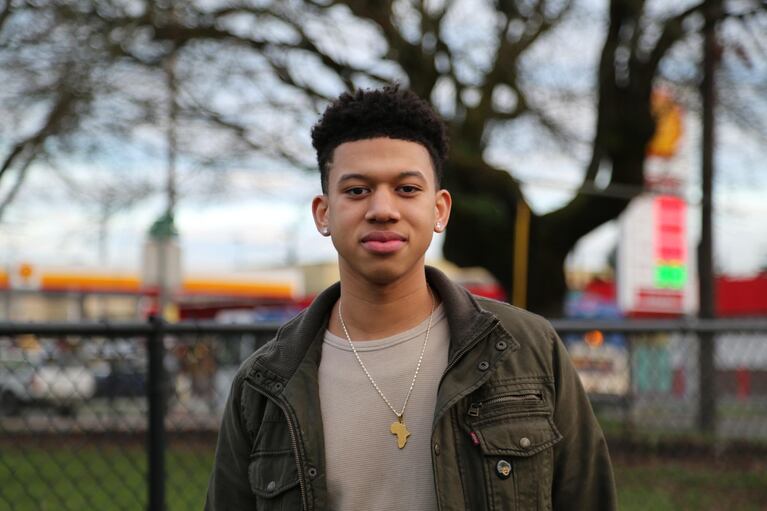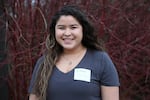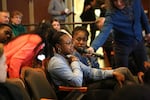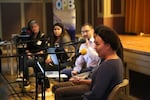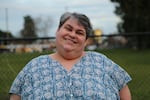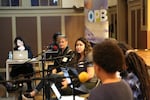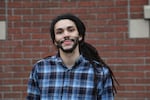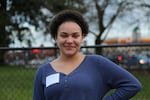
Tyler White is a member of the student advocacy group The CENTER, which collaborated with "Think Out Loud" for a live show on race and education.
Samantha Matsumoto / OPB
We listen back to a conversation with students, teachers and others in education about how race and racial identity are playing out – in curricula, class discussions and everyday life. We invited an audience to join us at the De La Salle North Catholic auditorium to discuss the real life experiences students have around race at school and explore ways that teachers can facilitate positive and productive discussions about race.
Our guests include high school students Sarah Steele, Karen Reyes, Jamie Bikales and Elijah Crawford; teachers Jayme Causey, Courtney Palmer and Cesar Ramirez; and Indian education director, Angie Morrill, Ph.D.
This show first aired in March, 2018.
The following transcript was created by a computer and edited by a volunteer.
Dave Miller: This is Think Out Loud on OPB and KLCC. I’m Dave Miller. We’re going to bring you a conversation right now that we recorded back in March of 2018. We did it in front of an audience at De La Salle North Catholic High School in North Portland. That was back when doing anything in front of an audience was a thing. It was the third show we had done in partnership with an educational and community organization in Portland known as The CENTER. In our first conversation, we talked about what the American dream means to young people. For the second, we got together a group of students from urban and rural high schools to talk about political polarization. This one was about race, and I have to say it was striking to go back to my introduction from that show. This is part of what I said two years ago. “At a time when non-violent protests over shootings of unarmed Black men are attacked for being un-American, when there are major debates about both illegal and legal immigration, when white supremacists seem emboldened, and when racial bias is under the national microscope like never before; we wanted to know how all this is playing out in high schools.” Again, that’s what I said two years ago. Needless to say, that national focus I mentioned has increased about a hundred fold. Partly because of that, we thought it would be a good time to listen back to this conversation and to hear what students and teachers had to say back in 2018. We’re going to hear from a number of them in the course of the hour. We started the show with Sarah Steele who was a junior at Jefferson High School in North Portland, and Jayme Causey, an English teacher there. I asked Sarah how much she talked about the Black Lives Matter movement or implicit bias or issues of equity in her classes.
Sarah Steele: At Jefferson High School, I’m pretty sure every grade has a social studies class every year that they’re at Jefferson. In social studies class, we talk about it the day after it happens, or as soon as we have that class after an event like that happens. But it’s usually quickly forgotten about, and then discussions on race and equity aren’t brought up again.
Miller: What are those conversations like, when you have them, before they get forgotten? Do you feel like you can say what you want to say, and you can have a productive conversation?
Steele: I feel as though it’s the teachers giving us the information on what happened and just informing the rest of the classroom. And we discuss fairly little. Sometimes.. It never takes up the full class period. Not usually half, it’s usually just at the beginning, but it’s not usually a full discussion about what’s happened.
Miller: What would a full discussion be like, what do you want to happen?
Steele: I want the students of color in the classroom to be able to share their feelings with the rest of the class and with the teachers. Because we don’t really have teachers of color at all. So we have those teachers trying to lead a conversation about race, and it usually doesn’t work out very well for the students of color.
Miller: You go to – this was the case a couple years ago, I think it’s still the case – the only majority African American high school, not just in Portland, but in the state of Oregon. And you’re saying that nevertheless, at Jefferson you feel like questions about race aren’t handled well in your classes.
Steele: They’re handled like, I feel, at the minimum that they could be handled. They’re talked about because they have to be talked about, but it doesn’t go that deep. And we don’t really have full discussions on it, where the students can say how they feel.
Miller: Jayme, as I mentioned, you’re an English teacher at Jefferson. My understanding though, is that your own high school experience was pretty different from Sarah’s, demographically. You’re also African American. You went to Grant High School which is now about 13% African American. What was high school like for you?
Jayme Causey: Whew. It’s a big question. Looking back on high school.. I feel like I’m more reflective looking back on high school, than I was observing while I was in it. And I think it was because there were so many pieces of myself that I had suppressed while I was in high school. Because I didn’t see teachers that looked like me. I didn’t see myself representing the curriculum, and I didn’t see just representation on any front from the books that we read to the videos we watched to the plays that I auditioned for. There wasn’t people that looked like me in front of me, or being presented to me, in ways that empowered them or empowered me. So I think I wasn’t critically aware of that while I was in high school, because I had pushed that part of myself down and tried to shrink my own cultural viewpoints, because I didn’t want to be othered or be singled out for that.
Miller: When did you realize that?
Causey: Honestly, this is my second year at Jefferson, and it probably wasn’t until I started teaching that I recognized (a) the importance of that in the classroom and (b) how much of that I did not get while I was in high school.
Miller: What do you think it does mean to your African American students in particular, and the boys among them, the young men, to see a man who looks like them teaching the class?
Causey: I hope it feels good, you know? I feel like we talk about race a lot in my class. But I feel like, even if we never spent one day talking about race, they will have gotten experience that I didn’t get through my entire schooling career.
Miller: Which is what?
Causey: Seeing someone that looks like them in the front of the room.
Miller: I want just a show of hands here for the students of color in our audience. How many of you have teachers currently, who look something like you, with whom you share race or ethnicity? How many of you, just by a show of hands, can say that? We have four hands raised, perhaps, out of dozens of students of color in the room right now. Does anybody mind sharing what that means to you? We’ll get a mic to you, if you don’t mind, telling us your name and where you go to school.
Sage (student): Hi, I’m Sage. I go to school at Jefferson and my teacher is Causey, right over there. Yeah, I didn’t know he’d even be here. I mean it really means a lot for me, because a lot of time I’m put down for being mixed. And the fact that Causey himself is also mixed, it’s a place where I can feel like I can talk to someone about it and get a good amount of support, because I trust him as a person and a teacher? And so it’s just a really great experience for me and I know the people around me as well, because he’s just a very well respected teacher, by people of color and people that aren’t people of color. He’s just always a person to talk to. Our curriculum always has a lot of comments about race. We spent weeks on studying Black Lives Matter, and why it’s bashed, and is that valid? And just a lot of great stuff to spark conversation, and make them happen naturally in the classroom, rather than just being shoved down your throat.
Miller: Jayme Causey, what the audience at home can’t see, is that you were tearing up a little bit as he was saying that. What does it mean to hear what you mean to just one of your students?
Causey: Again, it’s just that experience that I didn’t get in high school. And I try to make myself available for all students, but especially my students of color. Sorry, I’m not that composed right now, but it means a lot to hear that. And it means a lot that students feel like they can come talk to me about the experiences that they’re having. And it’s good to hear that the curriculum is sticking, and that these are discussions I think that kids want to have, but are unsure on how, or with who, or how to navigate these tough conversations. And I just try to make that available for all students. But there are obviously focus points that I hope they stick with.
Miller: Sarah, there’s another way to look at this, which is that the majority of the teachers in Portland public schools, and I think it’s probably fair to say around the country, are white. What do you want white teachers to do differently, or to do better?
Steele: I think regarding race in the classrooms into racial discussions in the classrooms. I would appreciate it if they began to take a back seat during those conversations, and be a moderator rather than a teacher, like what they’re used to being, they should let the students of color lead those conversations and talk about it as freely as they want to because, at Jefferson High School especially, it’s their space.
Miller: Have you made that suggestion?
Steele: I actually don’t think so.
Miller: You’re the president of the Black Student Union, right?
Steele: Yes.
Miller: What are your goals as the president of that union?
Steele: At Jefferson? It’s different than other Black student unions because we have a majority Black school. So the school is the safe place for the Black students. So our job mostly is giving back to those Black students and showing them that they are appreciated, that they are Black excellence and all that.
Miller: Jayme, I saw a video that you took part in a couple years ago, where you told a story about when you were a junior in high school, and a teacher came to class with an unusual assignment. I wonder if you could tell us that story.
Causey: Yes. I was a junior in high school at Grant. I was in my African American literature course, and my teacher, Russ Peterson, let us know that someone from the district was coming with an important announcement for us. I was a junior, so this was 2008. So this woman walks in. It was an older white lady and she said, “Hi I’m from PPS. I have an announcement. They’re changing the name of Grant High School to George Bush High.” And at the time we were outraged. There were comments flying off, there’s people jumping up and yelling in the room. It was chaos in there honestly. She finally settled us down. Because she [said] “I’ve got some points that I want to deliver to you.” And it turns out that she was actually a guest teacher. Her name was Linda Christensen, who some people in here probably know. She’s well known in the district. But it was actually a lead-in to a lesson on how names are important to people. And she went into talking about Native American boarding schools and how they strip people of their names as a way to separate them from their culture. But it was a way to rile up outrage in students in a topic that they cared about, as a lead-in to a deeper discussion about the history of erasure in the Native American community.
Miller: What lesson did you take from that as a teacher now?
Causey: I mean basically you have to meet kids where they are. And you have to get them excited, and enthralled, and sometimes angry about things that they care about and are important to them before you can take them back to what you want them to know. So meeting them up front in the now, and then giving back-story, will always be more beneficial for both of you, as a teacher and as a student, than expecting them to care about something just because you do.
Miller: Jayme Causey and Sarah Steele, thanks very much for starting us off.
Guests: Thank you. [Applause]
Miller: Jayme Causey is a Jefferson High School English teacher. Sarah Steele is a junior at Jefferson. If you’re just tuning in, we’re talking about how race and racism and ethnicity are talked about and dealt with in Portland high schools. We’re coming to you in front of an audience at Portland’s De La Salle North Catholic High School, but our guests and audience members have come from all around the city. I’m joined now by Karen Reyes, a senior at St Mary’s Academy, and Courtney Palmer, a teacher of African American and Latin American literature at Grant High School. Karen and Courtney, welcome to the show.
Guests: Thank you.
Miller: Karen first. You are a leader of a couple different groups at St Mary’s, including the women of color group and the Latino Student Union. Have you always been a student leader?
Karen Reyes: No, it really started at the end of my sophomore year into my junior year, where I really started seeking a lot of leadership, because I started seeing issues that needed to be fixed at St Mary’s.
Miller: Like what?
Reyes: I think that our students of color ratios could increase, first of all. I noticed that our students of color ratio is really, really low, and I didn’t see any students that looked like me in my classroom. I maybe had one or two in my classroom that I could share similarities with, and it was getting really hard for me to sit in a classroom of predominantly white students. And I said, nope, this is not happening. I’m going to speak up and really take my voice to the administration and tell them this has to change.
Miller: That’s an experience that not too many white people experience, perhaps in their lifetime, to spend a big chunk of time without anybody who looks like them. And I have to be totally honest, that I’m talking about myself as well, I haven’t experienced that.
Can you describe what that’s like?
Reyes: It feels like I can’t relate to anyone in my classroom, especially when we’re talking about certain issues in our classroom, especially like in history class. There’s absolutely no one that I can talk to you about my own history, nor do I learn that in my classroom, about the history of my parents and where they come from, and that’s important.
Miller: Where did they come from?
Reyes: My parents came from El Salvador. They immigrated here when they were 16 years old.
Miller: So you brought this to the school’s attention, as a leader of a student group. What kind of response did you get?
Reyes: We definitely faced a lot of battles. It was really, really hard. Women of Color in Action is kind of the bridge between student voice and the administration. We had been discussing over weeks how we could change this, and not take a huge step forward, but rather take it in little steps. And how can we get to where we need to be? We decided that hiring a director of equity and inclusion would be the first step to do so.
Women of Color in Action proposed that to the administration, and we finally had hired one this year, over the summer.
Miller: You convinced the administration to hire a whole new person?
Reyes: I mean, it took a lot of work, but we did. [Applause]
Miller: Has that made a difference?
Reyes: A huge difference.
Miller: What kinds of changes have you seen?
Reyes: When Dr. Da Verne Bell wasn’t at St Mary’s, right before we hired her, it was really hard because we felt like we had a lot of things on our plate. She’s been kind of carrying us along, so we’ve kind of been in the back seat. But she’s been able to talk to the administration and faculty and staff more on a professional level than we can. So of course she comes and drops in on our affinity groups and Women of Color in Action meetings, to hear what we have to say. And she has meetings individually with the administration.
Miller: And what about your first complaint? Which is that you need to have more students of color at St Mary’s. How do they respond to that?
Reyes: We got a lot more students of color, especially the freshmen this year. It’s very much more diverse than it was in my class at least.
Miller: Do you talk with them, the freshman, the new students who may be Latino, Latina, African American, whatever? Do you give them advice?
Reyes: Yes. We actually invite them to Women of Color in Action meetings on Fridays. So they come and we are able to come in as a community, to talk about things that we can improve at St Mary’s.
Miller: As I mentioned, Courtney Palmer is here as well, a literature teacher at Grant High School. Specifically she teaches African American literature and Latin American literature. Good to have you here.
Courtney Palmer: Thank you. Good to be here.
Miller: The folks in the audience here, they can see you, they can see that, like me, you are white. Folks at home can’t see that. How do you deal with teaching classes in African American literature and Latin American literature as a white teacher?
Courtney Palmer: Head on! The first couple of days of class are really devoted to acknowledging the giant elephant in the room, of the white lady standing up front, teaching Latin American and African American literature. Because I think it’s incredibly unsettling to walk into a classroom where you think you’re getting an experience that is specific to your culture or the background or the history that you hold dear, and you see me standing there.
Miller: So what do you say?
Palmer: I ask students openly, and address the fact that, yeah, I am a white teacher, here is why I’m here. I have the book learning background, I have a background in literature and race theory. I don’t have any of the cultural capacity; I have none of that knowledge. And that knowledge means everything to this literature. And so what I do, kind of like what you were talking about earlier with opening up the classroom and de-centering the power, I give it over to the students. I kind of man the ship and steer. But in so many ways they bring the stories and the power to the literature. I just provide them opportunities. And so we start out with, I want to say about two weeks of community building, where we talk about how we’re going to treat one another, what they expect of me as a leader of sorts in the classroom, what I need to advocate for for them.
Miller: Wait, it’s a literature course. But for the first two weeks, you’re not reading literature, you’re talking about the ground rules of how the class is going to operate?
Palmer: Our class is one long conversation on race. And if we can’t talk to each other about race, it’s going to fail everyone. So the most important thing that we can possibly do is build community in that room. And to think that literature is divorced of human emotion or background or culture, any of these things, I think is a fallacy. So we have to sit down with one another, deal with one another as humans in a room and figure out how we’re going to treat each other, and what expectations we have, and what happens when we read a text with the n-word in it. Each class gets to decide: are you saying it, are you not saying it? How do you want to approach this? Because it matters on a class-by-class, student-by-student basis.
Miller: How have different classes in different years responded to that question?
Palmer: The first year ... I took over this class, I was a first-year teacher, and they didn’t know who I was, and it was a class that didn’t have a lot of pride put into it, it didn’t feel like when I walked in. The students were there to get out of English, to get out of their senior year with having taken an English class. And it was at the end of the day and there were 33 kids crammed in there. It didn’t feel like they cared much, or even that they had selected it. It was more selected for them at the end of the day. So in the beginning having those conversations, it took some time because they wanted to know what in the heck I was doing there. And why I wanted to be in that room, because I did not look like I needed to be in that room, and it was hard. So the first year was rocky ...
Miller: Did you have an answer for that question, ‘why are you teaching African American literature or Latin American literature’?
Palmer: Because I want to give them a chance to access history and literature of people that they look like and recognize. And just because I don’t look like them or represent their culture doesn’t mean I don’t appreciate their culture to high heaven. It’s incredibly important to me that every single student is met with curriculum that matches them.
Miller: So back to the question that you said that every class you let them decide for themselves how they will handle the n-word , if you’re going to be reading out loud, for example. What are some of the different ways classes have answered that question?
Palmer: It can be colorful. I know I have, I’ve got a senior in here who’s been part of that conversation. So each one of my classes comes up with a kind of a constitution, it’s a living document. And I actually lifted this from a professor I had in grad school. When things get hard, we need to figure out how to talk about them. So Lauren, I see you back there.
Miller: What’s your name?
Lauren Ellis: My name is Lauren Ellis. I’m a senior at Grant High School, also the co-president of the Black Student Union. And I’m also a student of Miss Palmer’s. I take Miss Palmer’s African American lit class. We did have that discussion about, what are we gonna do around the n-word . And it’s come up this year in class, actually. We have had students who have said the n-word, and how do we address that? How do we resolve the conflict and the divide between the class, [that] somebody said something they shouldn’t have said, and how do we approach that? But my class, especially, in particular, we decided that we were not going to say the word. And that is what we made for our class.
Miller: Have any students/classes said the rule is that Black students can say the n-word in its entirety and nobody else can?
Palmer: Yeah, that has come up.
Miller: Which is, on some level, that is a version of a societal rule, an unwritten one, but something close to lived experience in America right now.
Palmer: Mm-hmm. That has absolutely come up. And on the heels of that, I showed Ta-Nehisi Coates’ response [https://www.youtube.com/watch?v=QO15S3WC9pg] on why white people shouldn’t say the n-word, just to reinforce for my white students, which I’ve got a lot, why that word can be kept out of their mouths.
Miller: I’m curious: we’re talking here about one literature class which takes this and many other issues head on, but have anybody else in the audience here in other classes, have you dealt with this particular word, or had encounters with other students using it?
Student named Jada: Hi, my name’s Jada. I also go to St Mary’s with Karen up there. So basically this happened in my, I want to say my sophomore English class. I was one of two students of color actually in my classroom. I think the other student was Latina. I had my English teacher, directly, as soon as the word came up in the book, I had her look at me and ask me if it was okay if we said the n-word, and I just said that like, “no, we should just skip over that, we should just not say that.” But it definitely felt awkward to be put on the spot like that. As the only Black student in the classroom, I feel like it’s just kind of a general rule: no, you can’t say that, you don’t need to put me on the spot like that in the classroom. So that was my experience.
Miller: Thanks very much for sharing that experience. What’s your name?
Student named Marie: My name is Marie and I attend OES.
Miller: That’s Oregon Episcopal School?
Marie: Yes. So last year I was new and we had 11th grade English and the teacher asked, well, the teacher asked a question and the whole class turned around and looked at me as if I was supposed to know the answer. And I was like, “I wasn’t a slave, I don’t know.” [Laughter] So it was really awkward because I didn’t know how to respond because, although I’m Black, I don’t represent the whole Black lineage and race. And so I didn’t know how to answer that question, but I can only infer depending on the text and what’s stated and so, yeah.
Miller: Thanks very much for sharing that experience. Courtney, have you seen improvements during your time at Grant?
Palmer: I have, I absolutely have…
Miller: Where?
Palmer: [Laughs] Within my classroom, I have a lot of free reign, which is fantastic. And so my little program that I know Jayme took African American lit when he was in high school, it’s been at Grant for about 20 years. It went from 33 students two years ago to 148 this year. So I have more than a third of the senior class. And so just within the building, as far as the students are concerned, white kids and kids of color are accessing that particular class by choice. So I see the tone of the students shifting. And just seeing the work that the kids do through the student equity committee, working with the faculty equity committee, to get culturally responsive curriculum and pedagogy in the classroom, is phenomenal. It kind of breaks my heart that it has to start with kids, but I’m proud of the kids for being the ones to push this when no one else will. And it makes faculty face it. I know that we have a few administrators that are very, very invested in equity work within the building, and we have some very powerful folks on staff too, that continue to get in front of the faculty and look at data, and look at ways we can teach more productively to more kids on a daily basis.
Miller: Courtney Palmer and Karen Reyes, thanks very much.
Palmer: Thank you.
Reyes: Thank you.
Miller: Courtney Palmer is a literature teacher at Grant High School and Karen Reyes is a senior at ST Mary’s Academy.
We have some more comments from members of our audience. What’s your name? Where do you go to school?
Sidney Wallace: My name is Sidney Wallace and I am a senior at Parkrose High School. Last year actually, the Parkrose High school girls basketball team took a trip down to South Albany High School and while they were there a very kind of traumatic incident occurred for them. As they were leaving, a lot of the South Albany students were kind of going out of their way to go on and they were blocking the bus, they were calling a lot of the girls on our team the n-word , monkeys, that kind of stuff. So, a very traumatic experience for them. And then, upon learning that information, we found out that their mascot actually used to be called the “Confederate Soldiers.” They have since changed their mascot to the “Rebel Soldiers” which isn’t much better because it’s the same thing basically. But we had some students from South Albany come up and have a big discussion with us, which was really interesting and I was able to be a part of that. There was a lot that was to be said in the conversation that we had with them. And obviously I don’t have the right answer and they didn’t have the right answer. We didn’t really come to a complete agreement, but I just think there’s a lot of discussion to be said for what kind of mascot you’re having representing your school and how that affects the students within it.
Miller: Thank you. We have another comment from somebody in our audience. What’s your name?
Marrone Samir: Marrone Samir. I go to Reynolds High School and I wonder, why would teachers teach a curriculum that is Eurocentric, but bring in segments or parts of the units and give their perspective instead of standing back and letting students voice in what they should be talking about.
Miller: That’s been your experience? That, for certain topics, you feel like teachers shut down conversation about things that you find, or other students find, important?
Samir: Yes.
Miller: Thanks very much for sharing your experience. Cesar Ramirez joins us now. He teaches Literature, Language Arts and Film as Literature at Benson High School. Good to have you here.
Cesar Ramirez: Nice to be here. Long time listener, first time panelist. [Laughter]
Miller: I have a bunch of questions for you, but do you want to answer the two questions that just came from our audience first? I mean your thoughts as somebody who thinks about images and literature and representation, the effects that a mascot has on a student body, say?
Ramirez: Yeah. There’s two sides to that coin because there’s that rebel imagery that is just littered with negative connotations that derive directly from Pre-Civil War and slavery and the negative effects that has on our Black and African American communities. But there’s also the other side where you have mascots that represent Native Americans that completely strip a whole group of people of their humanity and create a caricature of them. You see that imagery on a school building, you see that imagery on shirts and that’s what kids absorb. So, when they see someone who looks like that stereotypical caricature, they react a certain way; they treat that person as if they were less than. Because that’s what they’re bred to believe, that’s what they’re taught to believe.
Miller: And what about the other question that we got from the audience? The frustration that too often teachers shut down conversations about important things that students care about. How do you handle that as a teacher? Because my guess is that you have a syllabus, there are things that you have to cover. But there also may be times when students want to go deeper about something.
Ramirez: Yeah, I think when it comes to curriculum, there’s that fear of letting go of the steering wheel, that if you somehow step away from that metaphysical podium, that somehow, you know, you’re gonna go off the rails and everything is going to go wrong and it’s completely the opposite. Kids want to be, not only represented in what they’re learning, but they want to have a seat at the table and be able to contribute to their own education. Education is like a form of currency: when kids don’t feel like they are able to put forth their own time and effort into it, and they’re not gonna buy into their own learning experience. And they’re not gonna buy into your classroom. They’re just gonna be like, well let me just sit here for 90 minutes while this person bores me to death and then let me get out.
Miller: So what’s your approach? That sounds like a terrible one.. [Laughter.] So what’s your approach to teaching? How do you engage kids and get them to care about what you’re teaching?
Ramirez: First of all, representation matters: You have to look at your curriculum and ask yourself, “Why am I teaching this?” and “Are my kids represented in the curriculum in some way, shape or form?” Whether that be represented by race or experience or whatever that might be. In my film class, we look at the history of film and the way that film perpetuates negative stereotypes, especially early film but particularly stereotypes and tropes that are present today. We look at those and we analyze, not just the origins of what those stereotypes are, but how these big production companies, that are predominantly white, profit off of basically making a cartoon out of groups of individuals. So just leading those conversations and having kids bring in their own experience because people definitely watch a lot more movies than they read books. I know I do. The kids have a lot to say and they need to be able to have that microphone passed to them so that they can feel empowered and feel like they’re heard and not just spoken to.
Miller: Let’s pass the microphone to another member of our audience and what’s your name.
Ileana Grieta: Hi, I’m Ileana Grieta and I’m a senior at Cleveland [High School]. I wanted to go back to the conversation about the mascot. Cleveland used to be the Cleveland Indians and we changed to the Cleveland Warriors. But still now our dance team is the Sun Dancers. I’m not Native American so I can’t speak to that experience, but we’ve definitely had a lot of Native American students complain. And I just want to talk about the environment at Cleveland; I think that because we are still the Cleveland Sun Dancers, there’s an air of not really caring. I’ve heard that the dance team is like, “Well, that’s our tradition. We’ve had that name. I don’t understand why we should change it.” And I think that having mascots and other representation in that sort of negative way can kind of cause a lack of concern or a sort of, “It’s not really that important.’’ and I’ve definitely seen that at Cleveland.
Miller: Thanks very much for sharing that. We actually have Angie Morrill here, who is the Director of Indian Education for [Portland] Public Schools, who I was going to call anyway.. [Laughter] and then I saw that you’d put your hand up! We’re on the same page. The mic is yours.
Angie Morrill: Thank you. I think you’re absolutely right about the concerns. We have a lot of Native American students at Cleveland. And there’s two young women who are both seniors this year, who last year brought this to the principal’s attention, brought it to our attention. We had meetings with school administrators. Those meetings have been ongoing, in fact, they’re continuing. But the name’s changing. The name is absolutely changing; that’s been agreed upon. It’s just, there needs to be some restorative justice around it to make that complete. But you’re right. I think that decades of research has shown that Native American mascots -- I can’t even get my mind around a confederate rebel mascot, I’m sorry -- are very damaging. They’re not harmless, they aren’t honoring people. They are part of an erasure narrative that is incredibly damaging to Native American students who are going to encounter, like almost 99% of everything they encounter in the classroom talks about them in the past. It’s a part of that whole, “we won and you lost and you’re gone.” But we’re still here. I am curious to ask though, are there any Native American students in the audience? All right, hello! [Laughing.] I see you! [Laughter.]
Miller: Angie, you mentioned restorative justice; that’s going to be a part of the process of getting rid of the name. What does that mean in practice?
Morrill: In practice it means that Sunshine Guzman, who’s our student support specialist, has been sitting at the table with the dance team director -- people have a lot of feelings about these things -- the principal, some other people who want to be heard and she’s been wonderful enough to listen and let them get these things out. [It means] that the students who have been very offended and who began this activism, they’ve been checked in with at every turn, but they don’t necessarily want to be at that table.. You know, listening to how hard it is for them to change their racist name. I don’t know if you know why Sun Dancers is not a great name, but the Sun Dance is a ceremony and it’s a religious ceremony. It’s a ceremony that some of the students’ families practice, who go to Cleveland.
Miller: Angie, I want to hear more from you in just a bit. But Jamie Bikales is with us as well. He is a senior at Lincoln High School, former editor in chief of the school newspaper. Good to have you here.
Jamie Bikales: Thank you.
Miller: As editor in chief, how much did you report on issues of race or racism or equity?
Bikales: Yeah, this was a significant part of our reporting. We had last year, one reporter who chose to write for the whole year, a column on different issues of race that came up. Originally I thought that this was going to be kind of a commentary on ongoing issues. But it turned out -- and it was an eye opening experience to me -- that almost every month when we came out there was some new incident or event that she ended up writing about..
Miller: Like what? For people who aren’t familiar with what was happening at Lincoln last year, what kinds of things come to mind?
Bikales: So there have been incidents involving coaches at Lincoln who have made racist comments. Those have been pretty high profile. And then there have been other incidents that we’ve reported on, where teachers have made comments that made students feel uncomfortable. In addition, we have also reported on the positive side when students are getting out and being active. For example, we had a lot of students who were choosing to kneel at the football games earlier this year.
Miller: I don’t have all the demographic information in front of me right now, but my understanding from the past is that Lincoln is the least diverse of the public schools that we’ve been talking about so far within PPS [Portland Public Schools], the most white. How does that tie into what you’re talking about right now? How, for example, how’d the student body respond to these stories?
Bikales: I think, for the student body of Lincoln, it’s probably more shocking than it would be to the student body of schools that are more diverse. I think..
Miller: You mean people of color know how bad they’re treated regularly and white people are surprised that racism is happening here.
Bikales: Mm-hmm. And I think, at a school like Lincoln, inclusion and equity and community are really pushed. And when it’s revealed that even though there are people that may not look like the rest of the student body are feeling like they’re not part of that community, it can be shocking to people who have felt that they have fostered this type of community.
Miller: Have you felt that personally? You’re Korean and white?
Bikales: Mm-hmm.
Miller: Have you felt that as a student?
Bikales: Yeah, I’ve felt at times that there are, well, [at] Lincoln, the student body is very politically active. We saw this last year with the walkout that happened to promote the school bond. But this political activism, I feel can sometimes be one sided, and it’s often led by white students. As a result, there are sometimes assumptions that are made that can be made in the vein of being progressive or pushing social justice, but really haven’t included the perspective of other races and other groups. [Scattered applause]
Miller: We have another comment from our audience. What’s your name?
Gabrielle Cozy: Hi, my name is Gabrielle Cozy. I’m a junior at Lincoln High School. I am mixed: I’m half Black and I’m half white. This is going on my fourth year in Portland Oregon. There are quite a few things that I have picked up that are really specific to the Lincoln culture. A lot of times the teachers address the students as a white student body. And it is incredibly...
Miller: What does that mean to address students as a white student body?
Cozy: When you’re in a classroom, sometimes the teachers will say, “Well as white students,” we have to do this or we have to do that and they forget that there are students of color in the classroom. And what that does is it makes you feel like you are forgotten in the classroom. You feel like you don’t have a voice. You feel like it is only the white students who are being heard and that they have to be making the change. But what about me? I want to be making change too. My voice is just as important as theirs.
Miller: Thanks very much for sharing your experience. [Audience applause.] Elijah Crawford is with us as well. He’s a senior at Central Catholic High School. Elijah, good to have you here.
Elijah Crawford: Thank you, thank you.
Miller: My understanding is that you went to Boise-Eliot, a pretty diverse K-8 school, not that far from here in North Portland. And from there to Central Catholic, which is a lot whiter. What was that transition like?
Crawford: Well, I went from Boise-Eliot to SEI Academy for middle school, which was predominantly African American. Then I spent my freshman year at Grant High School, which was very white, and then I went to Central Catholic. But, coming from SEI, where everyone looked like me, to Grant and then Central was very different. It was.. It was hard. I remember my first day at Central as a sophomore. I walked into my English class and then I saw all white kids and one person who looked like me. And I just felt discouraged and I felt like I couldn’t be myself in that classroom and my opinion didn’t matter. And it was an adjustment; I had to adjust to it.
Miller: Do you feel like other people adjusted, too? Or is it all up to you to adjust?
Crawford: Other people, like?..
Miller: I mean white kids to make you feel at home or white teachers to say, “Yeah you belong here, too.” or was the adjustment all up to you?
Crawford: Personally, I felt like the people around me, the white people around me, were blind to the fact that I felt discouraged so they didn’t.. It wasn’t a big deal to them. So some I kind of had to figure out on my own and with the help of my family.
Miller: How’d you do that?
Crawford: I talked to my mom about it a lot. We have conversations like this a lot. With her help and her support. And with SEI’s help and support as well.
Miller: My understanding is that you actually now teach leadership class at SEI, Self Enhancement Inc, to fourth and fifth grade boys. What are you teaching them?
Crawford: So I teach a male leadership class to fourth and fifth grade African American boys at Boise-Eliot. It’s just an opportunity for them to see an African American male, someone who looks like them, striving to be something that they should be striving to be as well and provide mentorship. We talk about everything really. A typical class would look like.. We start off with our journals. One Journal is “What does leadership mean to you?” And then after the journals, we go into discussions; it’s kind of whatever they’re feeling that day. We usually focus on current events, though, and social justice issues.
Miller: What do you get out of that? It’s clear, or we can imagine what these fourth and fifth grade boys get, looking up to you, but what do you get out of it?
Crawford: Well, for me it’s amazing because I went to Boise. And I participated in classes similar to it. So, for me, I get to go back to where I came from and give back. And I think that’s pretty dope. [Audience applause]
Miller: Angie Morrill is here as well. We heard from her a little bit earlier talking about mascots and a change coming at Cleveland High School. Angie, what was your experience like as a Native student in Portland Public Schools in the 1970s?
Morrill: Yeah I went to Applegate and Ockley Green and Jefferson. So I’m all North Portland. It was rough. I had the experience of teachers saying, “you’re Native American..” And I know the audience here is like, “You are?” But the truth is, yeah, I am and my family is and we know we are. I’m Klamath and Modoc. I’m enrolled in the Klamath tribes. My mom and my whole family are really involved in [ ?? ] and working in the Native community in Portland. Everywhere I go, somebody knows somebody in my family because Indian Country is that small. But, yeah, I had the experience of.. I was feeling really, oh, militant in fourth grade because we had done this march, Wounded Knee had happened, I was hearing a lot of bad things about the U.S. Government. I was like, “I’m not standing up anymore for this flag, this isn’t my flag.” And so Mr. Hill at Applegate was like, “Stand up, Angie.”
Miller: Oh, for the pledge of allegiance in the morning.
Morrill: Yeah yeah. I was like, “No, no thank you.” And he was like, “Well they pay for your free lunches so I guess they’re your government.” In front of the whole class like that. And I dreaded Thanksgiving every year because, even if a teacher was trying to be nice, they’d be like, “Well what does your family think of Thanksgiving, Angie?” And by the time I graduated high school, even though I went to Jeff, I was like I’m never talking about race again with anybody. And now I have a Ph.D. in ethnic studies and it’s my job. [Laughter] But I was like, done. [Applause] [Laughing] I was done. I was like, “No, I don’t want to know what you think because it’s too painful.” And people would say so much around me because I’m not Black so they would just.. not see me. It doesn’t matter how many star quilts are on my bed or how many feathers or whatever. It’s like people don’t think of you as Native because they don’t think that there are Natives. So you really, it’s constantly an erasure, even when you’re not in school.
Miller: You started by talking in the past tense and you ended up in the present tense.
Morrill: Well, now my job is to take phone calls from upset parents who are like, “Why is this happening to my child?” School is a very violent experience for our Native American students. But I do workshops with student teachers. I’m on these different boards. One of the things that struck me earlier and had me feeling emotional is, I’m on the board of the Sapsik’ʷałá [Sapsikwala] teacher program for the University of Oregon where I’m an alum for my bachelor’s and having Native teachers is just something that you can’t.. It’s so important. I grew up in North Portland and I never had a teacher -- I had one, Miss Ito was my gym teacher one year at Ockley Green -- but I never had a teacher who had any intellectual presence who was not white. And that definitely made me feel that I, I mean, I barely graduated from high school. You know. I just dragged myself through. And I didn’t go to college till I was 38 but it didn’t stop me. Now I’m Dr. Angie but.. [Applause] Thank you! It still gives me chills! And I’m so happy to be back in my high school, back in my neighborhood, working with these families -- they mean the world to me -- working with the Native community. It’s hard to see what’s happening to our community because of the gentrification and stuff. I never thought Jefferson would not be a Title I school. But I’m here, I feel very much called to this position right now. But it is hard; we need teachers. Kate Brown signed [Senate Bill] 13, we’re gonna have Native American centered curriculum in the schools, ethnic studies is coming to PPS. I have hope. I have hope that all these things are going to make a big difference. But it’s not gonna be easy but look at all these amazing students. It gives me hope, it inspires me to work with these families.
Miller: Thank you to all of you. [Applause] Thanks so much to our audience here, to our guests in the second half: Cesar Ramirez, Jamie Bikales, Elijah Crawford, and Angie Morrill. Thanks as well to De La Salle North Catholic High School, to principal Tim Joy here for letting us take over for an evening, [Applause] and The CENTER’s Youth Collective.
Contact "Think Out Loud"
If you’d like to comment on any of the topics in this show, or suggest a topic of your own, please get in touch with us on Facebook or Twitter, send an email to thinkoutloud@opb.org, or you can leave a voicemail for us at 503-293-1983. The call-in phone number during the noon hour is 888-665-5865.

